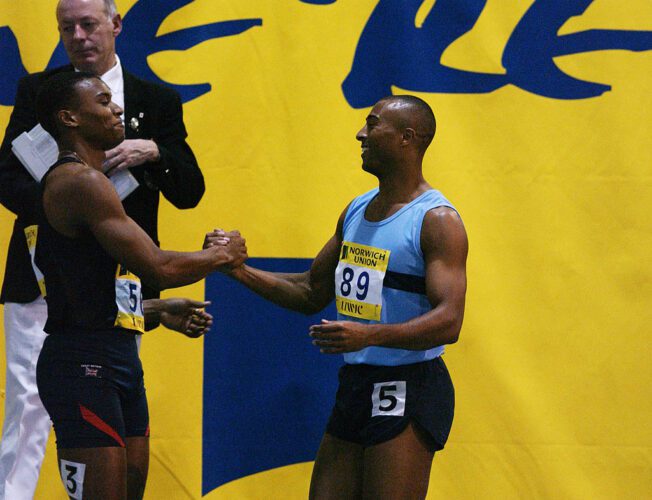What’s higher: three or five-stride hurdling? Becki Corridor asks Neuff ambassador Mensah Elliott
In the event you’ve been following Mensah Elliott’s pace, energy and mobility suggestions from half one in all this sequence, then little doubt you’re feeling quick, robust and (hopefully) supple.
So subsequent, it’s time to deal with one thing which nearly each masters hurdler will battle with sooner or later in time: the ever-changing hurdles spacing.
Three strides or 5 strides: the masters hurdler’s greatest problem!
As somebody who has been battling with this actual conundrum since turning 35 in September 2023, I’ve a barely vested curiosity in asking Elliott this query. Three strides are simply too far. If I five-stride, the hurdles come at me method too shortly. And I’ve received extra likelihood of working a marathon (completely out of the query) than with the ability to hurdle proficiently on each legs to permit me to four-stride.
And it’s a problem that many masters I do know have additionally struggled with.
“Look, three strides are at all times going to be the quickest – the optimum,” Elliott begins. “So, earlier than you go for 5 strides, strive every thing to get three first.”
At this level within the dialog, I needed to attempt to cover my disappointment!
The very first thing Elliott recommends making an attempt is “squeezing the hurdles in”. That’s, bringing them in in order that they’re nearer than race distance.
“Preserve the primary hurdle on the primary mark – that by no means modifications – after which place all the remainder of the hurdles two, three, or 4 toes in; till they’re shut sufficient that it forces you to do three strides,” he explains. “Begin with 5 or 6 hurdles, then add extra on. In the event you carry them in shut sufficient, you’ll get 12 or 13 hurdles within the 100m, or 14 or 15 within the 110m distance. Doing this may enhance your pace, your energy, and your endurance.”
And Elliott advises that as quickly as you’re feeling such as you’re having to shorten or chop your stride, take the hurdles again out once more by a foot or so.
This can be a methodology that he can vouch for from each an athlete’s and a coach’s perspective: he recurrently has his athletes prepare over hurdles which are a number of toes in from mark.
“Absolutely the worst factor to do is put the hurdles on mark and need to massively overstride to get between them”, Elliott explains.
“That impacts your method a lot. Whereas for those who carry them in and are capable of run and hurdle with higher method, you step by step get to the purpose the place the hurdles really feel too shut and you’ll start to edge them out once more.”
Elliott additionally recognises that a big a part of the problem with hurdles is a insecurity on the subject of the take-off distance, which he says can really influence your method.
“One factor I’ve seen – particularly with feminine hurdlers like these at my membership, S-Issue Academy – is the lead leg usually goes to the surface relatively than going straight over the hurdle; as a result of mentally they really feel that they need to get actually near the hurdle earlier than they go over it. Then they’re too shut, they suppose they’re going to hit it, and their leg finally ends up going out to the facet,” he observes.
“That leg going out to the facet slows you down, breaks your stride, and makes it tougher to get to the subsequent barrier. The goal is to assault the hurdle straight on and snap that lead leg down, constructing momentum.
“It’s a case of being courageous sufficient to know that you could take off additional again from the hurdle with the pace and momentum that you just’ve already constructed.”
And sustaining momentum is one other difficulty that masters hurdlers can wrestle with: going over all 10 hurdles in a 100m hurdles or 110m hurdles outside race is a problem.
“When you’ve received the spacing, to succeed in the top, you’ve to do a great deal of 120- and 150-metre sprints in coaching,” he advises.
“If I needed to do a 110m hurdles race within the early spring, I’d wrestle as a result of I spend all winter coaching to run 60m indoors. However for me, as quickly because the indoors end in March, I’m outdoors working flat-out 150s and going over 12 hurdles.”

Many masters hurdlers wrestle with making the gap to the primary hurdle; both it’s too far-off, or too shut as a result of the hurdle distances have modified. What would you advocate?
Equally to three-striding, there may be an “best” variety of steps to the primary hurdle, too. “If a masters athlete nonetheless has the identical energy and energy in these first few steps, and so they can preserve eight strides to the primary hurdle, then that’s finest,” he says.
“I nonetheless use eight strides. Lots of the youthful hurdlers – by that, I imply worldwide hurdlers of their 20s – at the moment are working even seven strides to the primary hurdle. I haven’t tried seven but, however I do know once I transfer as much as M50, I’ll in all probability need to, as that first hurdle will probably be nearer to me.”
And getting that first hurdle proper is paramount to the remainder of your run.
“For me, the primary hurdle is a very powerful,” explains Elliott. “In case your setup is mistaken, you mess up the entire race. Then you definately’re taking part in catch–up, and for those who’re racing in opposition to athletes of the identical calibre, it’s too late to repair.”
For these struggling to make the eight strides work, there are just a few choices.
“One possibility is to swap legs within the blocks and slot in seven strides – particularly for those who’re struggling as a result of the primary hurdle is just too shut,” Elliott explains.
“The opposite possibility is to regulate the block place. You don’t at all times have to position your arms on the beginning line. Certainly one of my taller athletes struggled with reaching the primary hurdle, so I instructed her to maneuver her blocks half a foot again. That small change gave her the area she wanted to hit her stride sample cleanly.”
One other adjustment might be made within the first few steps.
“It’s also possible to take a look at your first one or two strides. If the primary hurdle is just too far-off, make the primary stride massive – and even the primary two massive – then flip over shortly from there. Or for those who’re getting too near the hurdle, shorten the primary couple of strides after which lengthen them as you strategy the hurdle.”
And if not one of the different changes work – shifting the blocks, altering the primary few steps – there’s yet another possibility: but it surely comes with a caveat.
“If the gap to the primary hurdle continues to be too far, strive 9 strides. However for those who do, it must be fast turnover. 9 strides can change into 9 very quick uneven strides, in order that they need to be quick; they will’t injury your momentum into the hurdle,” he warns.

We’ve spoken lots about how hurdlers can preserve their type as they transition from senior to masters hurdles, however how would you advocate that individuals who have by no means hurdled earlier than go about beginning?
One of many nice issues about masters athletics is that it attracts new individuals who be a part of the group and provides the game a strive for the primary time, in addition to these already concerned in athletics who tackle new occasions after they attain 35.
As a part of his voluntary function as a Neuff ambassador, Elliott is enthusiastic about encouraging different masters athletes to offer hurdling a go.
So, for those who’ve been impressed, Elliott’s additionally received some nice recommendation for you.
For full rookies, the most effective strategy is to start out small. “Get some SAQ hurdles, preserve the primary one on the mark, squeeze the subsequent ones in, and simply construct your confidence,” he suggests. Slightly than instantly making an attempt to hit three strides between hurdles, athletes ought to first give attention to merely working between them.
“It’s not possible that somebody who’s by no means hurdled earlier than can put them on practically full mark and go over in three strides,” he explains. “Simply get used to working between them first – ideally utilizing the identical lead leg every time, so perhaps strive 5 strides first.”
As you get extra assured, preserve the peak low however area the hurdles out. Whenever you really feel such as you’re chopping your stride, that’s your cue to lift the hurdles barely, area them out once more, and start trying three strides.
If three strides are too difficult, transfer again to 5, construct confidence, after which strive three once more. Mensah warns that rising the hurdle top also can change your method, significantly the path leg, so it’s essential to progress step by step.
Discovering a educated coach might be useful, however Mensah acknowledges that hurdle coaches are uncommon. “Even once I was a senior athlete, there have been very, only a few specialist hurdle coaches,” he says. “However there’s a great deal of stuff on YouTube – some good, some not so good, however for those who keep on with the fundamentals, you’ll get someplace.”

Get your thoughts and physique in sync: and hearken to the latter
Longevity in hurdling isn’t about pushing by way of with the identical strategy you had in your 20s – it’s about adapting. Prioritising mobility, energy, and good coaching is not going to solely preserve you aggressive but in addition assist stop accidents and extend your time within the sport.
“After I got here again after my 5 or 6 years off, mentally, I used to be nonetheless within the place of an elite athlete. I assumed I might prepare six days per week, similar to earlier than,” he says. “So I went out to the monitor, did one session – felt good. The subsequent day, I did one other session – hamstring went.”
It was solely a grade-one tear, but it surely saved Elliott longer to regulate to than he was used to. And that was the second actuality hit: restoration wasn’t going to be as fast because it was. “After I was youthful, one thing like that will set me again just a few days. This took weeks!”
He says it took round 18 months for his mind and physique to completely “sync” up once more, for him to hearken to what his physique was telling him and settle for that some issues – just like the heavy lifting he spoke about in half one in all this text – wanted to be considerably diminished, whereas others, like flexibility and mobility, wanted extra consideration than ever earlier than.
Now, Elliott is extra conscious of the modifications in his physique, however is doing every thing he can to extend his profession. “I do nonetheless have issues with my again,” he admits. “I’ve had these days the place I’ve been hunched over as a result of I’m in a lot ache. I’m simply extra smart now with my coaching. Fortunately, I don’t suppose I’ve began to lose top from being hunched over simply but – I believe I’m nonetheless holding on to my six foot!”
And, after constructing on his success all through the years, his recommendation is obvious: preserve flexibility, construct useful energy, and don’t neglect pace work. For masters hurdlers, success comes all the way down to consistency and making the fitting decisions for long-term progress. Preserve refining, preserve enhancing, and also you’ll preserve clearing hurdles for years to come back.


